St Fagans 'hidden' gems give World War I insight
- Published

Soldiers used the Italian Garden outside the castle at St Fagans as part of their recuperation
Museum curators trawling through archives for an exhibition on World War I have uncovered hidden gems about Welsh life during the conflict.
Photos, uniform and craftwork have been found showing how St Fagans Castle, near Cardiff, was used as a hospital for soldiers.
Staff at the National History Museum, which is now based there, say they show another side to the Great War.
But they are keen to find out more about the people in the pictures.

St Fagans Castle was the summer residence for the wealthy Plymouth family
The team at St Fagans are going back through old archives and collections, looking for items that could shed light on what life would have been like in Wales during the World War I years from 1914 to 1918.
They will use the information they find for events planned to mark the centenary of the start of the war in 2014, along with a permanent exhibition for 2016 when the museum is renovated.
Because items at the museum have not been catalogued together under a specific war category, curators are having to painstakingly sort through all the collections and items in storage looking with "fresh eyes" to see if anything is relevant to the conflict.
The museum has always known that St Fagans Castle - an Elizabethan manor house which was the summer residence of the wealthy Plymouth family - had been used as a convalescence hospital during World War I.
There had been about 40 beds in the banqueting hall - which has since burnt down - and staff from the estate would help nurses tend to the men.
But until now, very few details were known about what happened at the V.A.D. (Voluntary Aid Detachment) Hospital and who was there.
Sioned Hughes, the museum's curator of politics, trade and religion, said they had found items that had been forgotten about or wrongly categorized.
"We have uncovered lots of things that tell the human stories there," she said.
"For example, we have an intricate butterfly-shaped belt buckle made from beads. I initially didn't think it was linked to the world war but it was in fact made by a soldier - a Cpl W. Stinson - in the hospital.
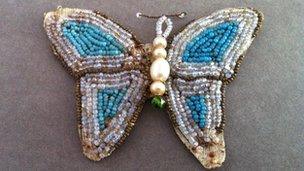
This intricate butterfly belt buckle was made by a soldier - a Cpl W. Stinson, who was at the hospital
"Lady Plymouth was quite active within the Red Cross and, like a lot of landed gentry in the war, they opened up their home to help.
"The butterfly - and an accompanying necklace - shows that the soldiers were doing very intricate and delicate art during their time at the hospital.
"It might have been a form of therapy. We think - but can't be sure - that they were there because they had post-traumatic stress disorder, or shellshock as it was known then.
"I think it shows another side to the war."
However, despite having photographs and a nurse's uniform from the time - along with the crafts - museum staff desperately want to find out more about the people behind them.
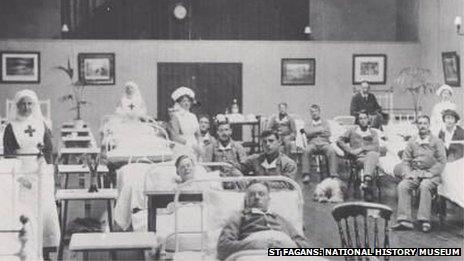
Curators would like to know more about the soldiers and nurses at the hospital in St Fagans - and are hoping members of the public can help
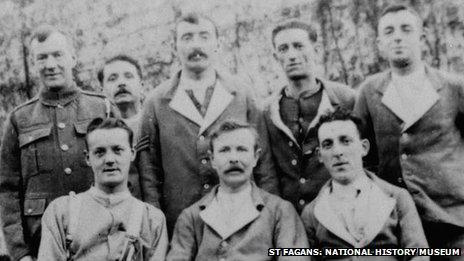
Staff know that the man in the top right hand corner of this photograph was Cpl W. Stinson, who made the butterfly belt buckle while at the hospital, but do not know anything else about him - or the other soldiers pictured

Gladys May Evans (1898-1952) was a land girl who worked the St Fagans estate during the war years. The 1901 census shows she was from the Margam area of Port Talbot, but little else is known
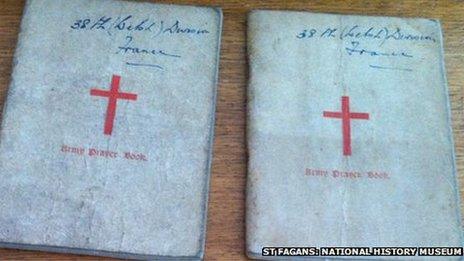
These prayer books believed to be used on the battlefields of France were donated to the museum - on their covers is written '38th (Welsh) Division France'. A communion book was also donated and inside the name J B Williams is written. Staff would like to know who this is
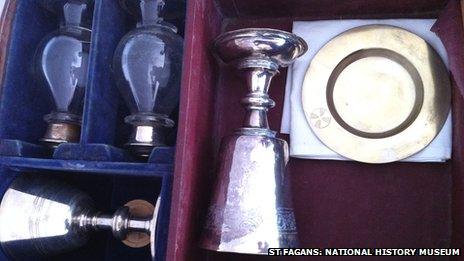
This box of communion glasses and silverware, also thought to have been used on the battlefields, was donated to the National Museum Wales in 1919 and belonged to Cpt the Rev Bowen-Williams. Again, curators would like to know more about the Mr Bowen-Williams
Elen Phillips, curator of costumes and textiles, said they hoped members of the public could help fill in gaps in their knowledge.
"The research is still in its infancy," she said.
"There are a number of personalities we know about but we don't know much about them or what happened to them after the war.
"You do become quite attached to these people because you spend so much time researching them."
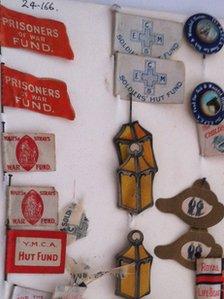
World War I badges show the charitable causes people supported
Curators have also found a communion book and prayer books, along with a box of communion drinking glasses and silverware that appear to have been used on the battlefields of France.
"They were in our religious collections but we believe they are related to World War I," said Ms Hughes.
"I think they would have been used on the battlefield for the soldiers. They probably took communion and you can only imagine the circumstances of that."
The finds also show how the local community continued to support soldiers after the war, with photographs from the 1930s suggesting that the Plymouth family, who themselves lost a son in the conflict, hosted reunion dinners for veterans.
Ms Hughes has also uncovered a box full of lapel pins - similar to charity badges received today for donating money to good causes.
"Some of the charities are very revealing, such as Cardiff Wounded Soldiers Extra Comfort for Christmas, Prisoners of War Fund and the Welsh National Hospital," she added.
"They were quite a find. My heart beat quite fast when I saw them."
- Published28 November 2012
- Published20 July 2012